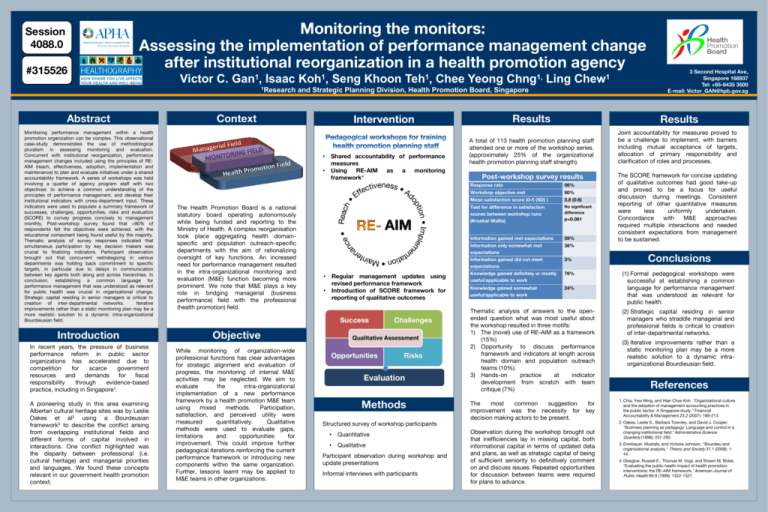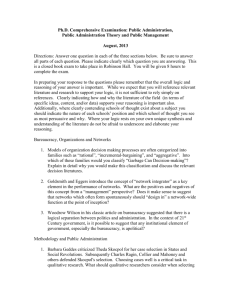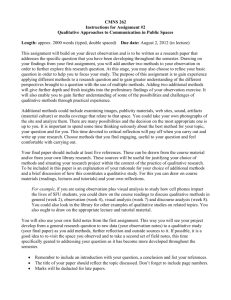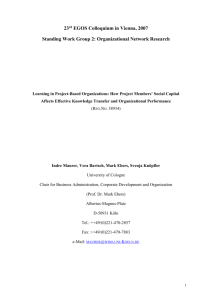Monitoring the monitors: Assessing the implementation of
advertisement

Session 4088.0 #315526 Monitoring the monitors: Assessing the implementation of performance management change after institutional reorganization in a health promotion agency Victor C. Gan1, Isaac Koh1, Seng Khoon Teh1, Chee Yeong Chng1, Ling Chew1 1Research Abstract Monitoring performance management within a health promotion organization can be complex. This observational case-study demonstrates the use of methodological pluralism in assessing monitoring and evaluation. Concurrent with institutional reorganization, performance management changes included using the principles of REAIM (reach, effectiveness, adoption, implementation and maintenance) to plan and evaluate initiatives under a shared accountability framework. A series of workshops was held involving a quarter of agency program staff with two objectives: to achieve a common understanding of the principles of performance management, and develop their institutional indicators with cross-department input. These indicators were used to populate a summary framework of successes, challenges, opportunities, risks and evaluation (SCORE) to convey progress concisely to management monthly. Post-workshop survey found that >90% of respondents felt the objectives were achieved, with the educational component being found useful by the majority. Thematic analysis of survey responses indicated that simultaneous participation by key decision makers was crucial to finalizing indicators. Participant observation brought out that concurrent restrategizing in various departments was holding back commitment to specific targets, in particular due to delays in communication between key agents both along and across hierarchies. In conclusion, establishing a common language for performance management that was understood as relevant for public health was crucial in organizational change. Strategic capital residing in senior managers is critical to creation of inter-departmental networks. Iterative improvements rather than a static monitoring plan may be a more realistic solution to a dynamic intra-organizational Bourdieusian field. Introduction In recent years, the pressure of business performance reform in public sector organizations has accelerated due to competition for scarce government resources and demands for fiscal responsibility through evidence-based practice, including in Singapore1. A pioneering study in this area examining Albertan cultural heritage sites was by Leslie Oakes et al2 using a Bourdeusian framework3 to describe the conflict arising from overlapping institutional fields and different forms of capital involved in interactions. One conflict highlighted was the disparity between professional (i.e. cultural heritage) and managerial priorities and languages. We found these concepts relevant in our government health promotion context. Context and Strategic Planning Division, Health Promotion Board, Singapore • Shared accountability of performance measures • Using RE-AIM as a monitoring framework4 The Health Promotion Board is a national statutory board operating autonomously while being funded and reporting to the Ministry of Health. A complex reorganisation took place aggregating health domainspecific and population outreach-specific departments with the aim of rationalizing oversight of key functions. An increased need for performance management resulted in the intra-organizational monitoring and evaluation (M&E) function becoming more prominent. We note that M&E plays a key role in bridging managerial (business performance) field with the professional (health promotion) field. AIM • Regular management updates using revised performance framework • Introduction of SCORE framework for reporting of qualitative outcomes Success Objective While monitoring of organization-wide professional functions has clear advantages for strategic alignment and evaluation of progress, the monitoring of internal M&E activities may be neglected. We aim to evaluate the intra-organizational implementation of a new performance framework by a health promotion M&E team using mixed methods. Participation, satisfaction, and perceived utility were measured quantitatively. Qualitative methods were used to evaluate gaps, limitations and opportunities for improvement. This could improve further pedagogical iterations reinforcing the current performance framework or introducing new components within the same organization. Further, lessons learnt may be applied to M&E teams in other organizations. Results Intervention Challenges Qualitative Assessment Opportunities Risks Evaluation Methods Structured survey of workshop participants • Quantitative • Qualitative Participant observation during workshop and update presentations Informal interviews with participants 3 Second Hospital Ave, Singapore 168937 Tel: +65-6435 3500 E-mail: Victor_GAN@hpb.gov.sg Results A total of 113 health promotion planning staff attended one or more of the workshop series. (approximately 25% of the organizational health promotion planning staff strength). Post-workshop survey results Response rate 56% Workshop objective met 90% Mean satisfaction score (0-5 (SD) ) 3.8 (0.6) Test for difference in satisfaction scores between workshop runs (Kruskal-Wallis) No significant difference Information gained met expectations 59% Information only somewhat met expectations Information gained did not meet expectations Knowledge gained definitely or mostly useful/applicable to work 38% Knowledge gained somewhat useful/applicable to work 24% p=0.061 3% 76% Joint accountability for measures proved to be a challenge to implement, with barriers including mutual acceptance of targets, allocation of primary responsibility and clarification of roles and processes. The SCORE framework for concise updating of qualitative outcomes had good take-up and proved to be a focus for useful discussion during meetings. Consistent reporting of other quantitative measures were less uniformly undertaken. Concordance with M&E approaches required multiple interactions and needed consistent expectations from management to be sustained. Conclusions (1) Formal pedagogical workshops were successful at establishing a common language for performance management that was understood as relevant for public health. Thematic analysis of answers to the openended question what was most useful about the workshop resulted in three motifs: 1) The (novel) use of RE-AIM as a framework (15%) 2) Opportunity to discuss performance framework and indicators at length across health domain and population outreach teams (10%). 3) Hands-on practice at indicator development from scratch with team critique (7%) (2) Strategic capital residing in senior managers who straddle managerial and professional fields is critical to creation of inter-departmental networks. The most common suggestion for improvement was the necessity for key decision making actors to be present. 1. Chia, Yew Ming, and Hian Chye Koh. "Organizational culture and the adoption of management accounting practices in the public sector: A Singapore study." Financial Accountability & Management 23.2 (2007): 189-213. Observation during the workshop brought out that inefficiencies lay in missing capital, both informational capital in terms of updated data and plans, as well as strategic capital of being of sufficient seniority to definitively comment on and discuss issues. Repeated opportunities for discussion between teams were required for plans to advance. (3) Iterative improvements rather than a static monitoring plan may be a more realistic solution to a dynamic intraorganizational Bourdieusian field. References 2. Oakes, Leslie S., Barbara Townley, and David J. Cooper. "Business planning as pedagogy: Language and control in a changing institutional field."Administrative Science Quarterly (1998): 257-292. 3. Emirbayer, Mustafa, and Victoria Johnson. "Bourdieu and organizational analysis." Theory and Society 37.1 (2008): 144. 4. Glasgow, Russell E., Thomas M. Vogt, and Shawn M. Boles. "Evaluating the public health impact of health promotion interventions: the RE-AIM framework."American Journal of Public Health 89.9 (1999): 1322-1327.







